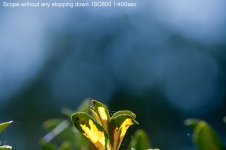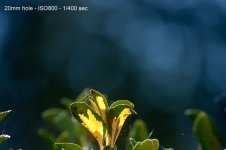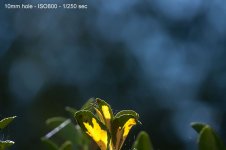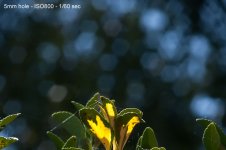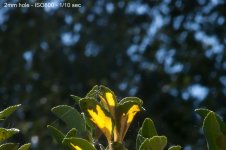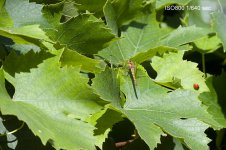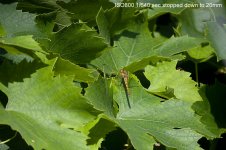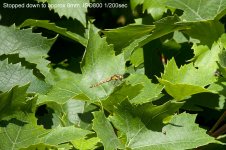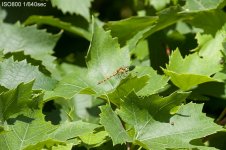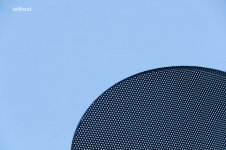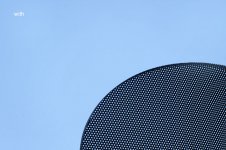Paul Corfield
Well-known member
Here's a series of photos taken with a set of diaphragm blades out of an old lens. The assembly needs to be right up in the scope, pretty much at the end of the focuser and this insures no vignetting no matter how small you stop it down.
With the blades wide open at around 20mm I could shoot at the same shutter speed as with the scope that hasn't been stopped down. It's interesting to note though that when you compare the first two photos, the one with the 20mm has a nicer contrast over all. With the scope in standard mode the bright light starts to invade the edges of the photo but stopping down with the blades wide open you get a constant overall contrast.
At the other extreme, the 2mm hole was a bit unusable as the depth of field was so great that going from in focus to out of focus took so long that it was hard to tell when it was spot on. And at only 1/10 sec it's a bit slow in bright sunlight. Anything above 5mm was fine.
The subject was only 6m (20 feet) away but the background trees were about another 25m (82 feet) away or 30m (100 feet) overall.
Apart from depth of field being increased, the main things you get from this are better contrast and a way to control bokeh.
Without going to the lengths I've gone to with dismantling a lens, I'd say a good modification would be to reduce the hole at the end of the focuser to about 20mm to get the same effect I'm getting in the second photo and no loss in shutter speed.
Paul.
With the blades wide open at around 20mm I could shoot at the same shutter speed as with the scope that hasn't been stopped down. It's interesting to note though that when you compare the first two photos, the one with the 20mm has a nicer contrast over all. With the scope in standard mode the bright light starts to invade the edges of the photo but stopping down with the blades wide open you get a constant overall contrast.
At the other extreme, the 2mm hole was a bit unusable as the depth of field was so great that going from in focus to out of focus took so long that it was hard to tell when it was spot on. And at only 1/10 sec it's a bit slow in bright sunlight. Anything above 5mm was fine.
The subject was only 6m (20 feet) away but the background trees were about another 25m (82 feet) away or 30m (100 feet) overall.
Apart from depth of field being increased, the main things you get from this are better contrast and a way to control bokeh.
Without going to the lengths I've gone to with dismantling a lens, I'd say a good modification would be to reduce the hole at the end of the focuser to about 20mm to get the same effect I'm getting in the second photo and no loss in shutter speed.
Paul.
Attachments
Last edited:




